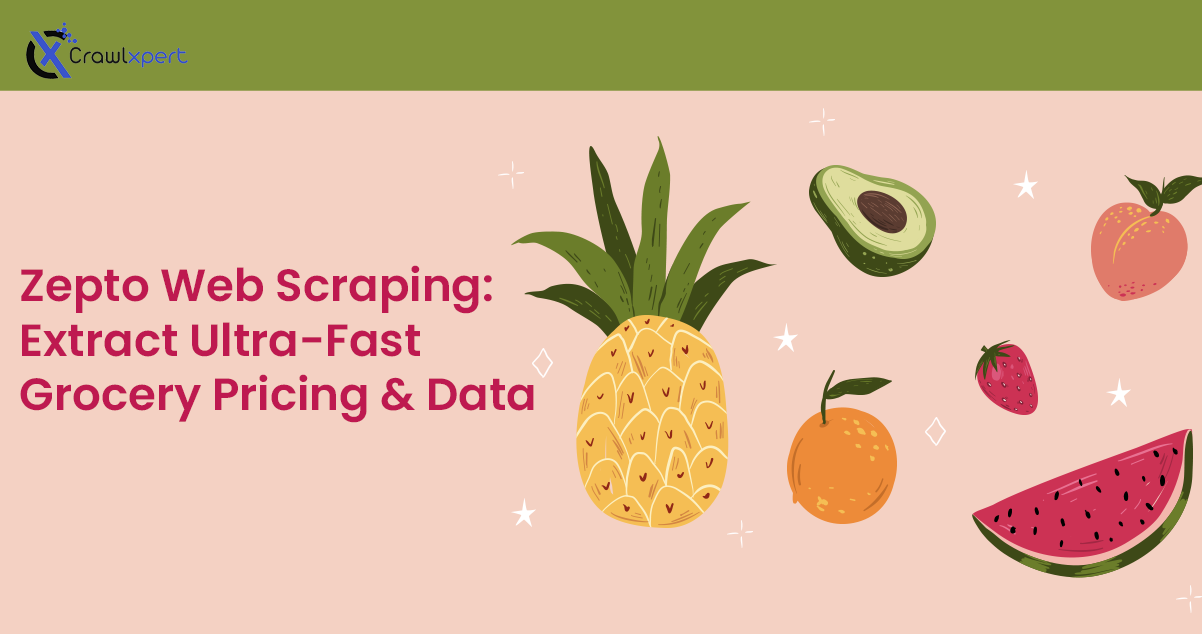
Zepto Web Scraping: A Guide to Extracting Ultra-Fast Grocery Data
Apr 14, 2025
Introduction
E-commerce is developing rapidly, and Zepto is swiftly becoming a game changer with its supermarket-to-door delivery services in just 10 minutes. Zepto provides critical consumption data that businesses and analysts can leverage for quick predictive modeling, consumer trend analysis, pricing, and product data collection as consumers demand more immediate and convenient grocery deliveries.
Scraping Zepto can prove to be quite insightful toward pricing and product availability trends, as well as consumer preferences about grocery demand in a data-driven decision-making company.
This detailed guide will take you through all stages of web scraping Zepto's grocery data—from tools and techniques to challenges, techniques, and best practices.
1. What is Zepto Web Scraping?
Zepto web scraping is the process of programmatic extraction of data from Zepto's website or mobile app. Typically, it includes end data such as:
- Product Listings: Names, categories, and descriptions of grocery items.
- Pricing Data: Regular prices, discounted rates, and offers.
- Availability Status: Stock information, including in-stock and out-of-stock items.
- Delivery Information: Delivery time estimates, regions covered, and delivery charges.
- Customer Reviews and Ratings: Feedback, comments, and star ratings.
The analysis of Zepto's grocery delivery ecosystem for competitive benchmarking and market trend identification can be executed through the automated data collection process.
2. Why Scrape Zepto’s Grocery Data?
Extracting Zepto’s grocery data offers significant benefits for businesses, market researchers, and analysts. Here are the key reasons:
(a) Competitive Pricing Analysis
- Price Comparison: Compare the grocery prices of Zepto against competitors like BigBasket, Blinkit, and Swiggy Instamart.
- Dynamic Pricing: Use real-time pricing data to update pricing according to Zepto's pricing in the market.
- Discount Tracking: Track current offers and discounts on Zepto to remain competitive.
(b) Product Availability and Stock Monitoring
- Track Inventory: Identify which products are frequently out of stock.
- Demand Forecasting: Use stock trends to forecast product demand and optimize supply chains.
(c) Market Trends and Consumer Insights
- Identify Trending Products: Determine which items are popular based on stock fluctuations and reviews.
- Analyze Consumer Preferences: Gain insights into purchasing patterns and preferences through product reviews and ratings.
(d) Business Intelligence and Strategy
- Retail Analytics: Leverage scraped data for retail strategies, demand analysis, and customer segmentation.
- Competitor Benchmarking: Use Zepto’s grocery data to benchmark competitors and make informed business decisions.
3. Tools and Technologies for Scraping Zepto
(a) Python Libraries for Scraping
- BeautifulSoup
- Requests
- Selenium
- Scrapy
- Pandas
(b) Proxy Services
- Bright Data
- Smartproxy
- ScraperAPI
(c) Browser Automation Tools
- Playwright
- Puppeteer
(d) Data Storage Options
- CSV/Excel
- MongoDB/MySQL
- Cloud Storage (Amazon S3, Google Cloud, Azure)
4. Setting Up Your Zepto Scraper
(a) Install Required Libraries
Use pip to install required Python libraries:
pip install requests beautifulsoup4 selenium pandas
(b) Inspect Zepto’s Website Structure
- Open Zepto’s website in Chrome.
- Right-click → Inspect → Elements.
- Identify product containers, price tags, and availability status elements.
- Use Chrome DevTools to explore the HTML structure and AJAX calls.
(c) Fetching the Zepto Page
Use the requests library to send an HTTP request and parse it:
(d) Extracting Product Listings and Prices
Sample code to extract data:
import requests
from bs4 import BeautifulSoup
url = 'https://www.zepto.com/'
headers = {'User-Agent': 'Mozilla/5.0'}
response = requests.get(url, headers=headers)
soup = BeautifulSoup(response.content, 'html.parser')
products = soup.find_all('div', class_='product-item')
for product in products:
name = product.find('h3').text.strip()
price = product.find('span', class_='price').text.strip()
print(f'Product: {name}, Price: {price}')
5. Bypassing Anti-Scraping Measures
Zepto employs anti-bot measures like rate-limiting and CAPTCHAs. Here’s how to bypass them:
(a) Use Proxy Rotation
- Rotate IP addresses to avoid detection.
- Use residential proxies for better anonymity.
(b) User-Agent Rotation
- Rotate the User-Agent header to simulate different browsers.
(c) Using Selenium for Dynamic Content
Use Selenium to load JavaScript-rendered content and extract HTML.
6. Data Cleaning and Storage
After scraping, clean and export your data using Pandas:
import pandas as pd
data = {'Product': ['Milk', 'Bread'], 'Price': ['₹60', '₹40']}
df = pd.DataFrame(data)
df.to_csv('zepto_grocery_data.csv', index=False)
7. Best Practices for Zepto Web Scraping
- Respect Zepto’s Terms of Service
- Use Rate Limiting
- Avoid Overloading Servers
- Monitor Data Quality
8. Legal and Ethical Considerations
- Compliance with Zepto’s Terms
- Data Privacy
- Use Data Ethically
Conclusion
Gathering grocery data from Zepto can help businesses with competitive pricing insight, availability of products, as well as consumer preferences. One can draw highly relevant data with proper scraping tools capable of bypassing the anti-scraping measures and use that for business-organized decision-making.
Best Practices should be upheld and adhered to in legal regulations set. It is by responsible application of web scraping that one can gain insightful SWOT analysis for staying in shape in this fast-moving grocery delivery marketplace.

